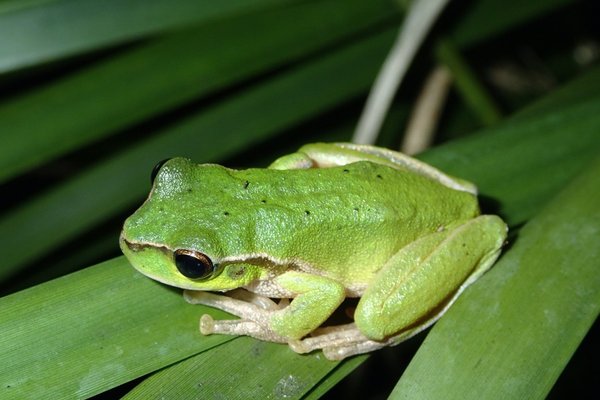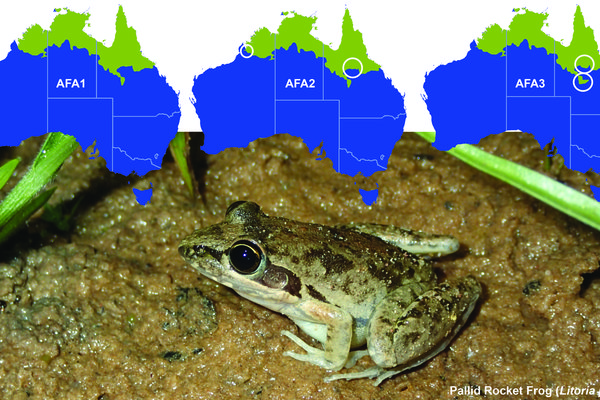The FrogID dataset 4.0: almost half a million frog records now online and open access
The fourth annual release of the FrogID dataset has just been released, ready to help inform conservation!
Almost all of Australia’s 246 native frogs occur nowhere else on earth. They span the continent, from the lush rainforests of North Queensland to some of our driest deserts. Frogs play a vital role in freshwater and terrestrial ecosystems across the country, but unfortunately, they are in a lot of trouble. Australia has already lost at least four species of frog, and several dozen others are threatened with extinction. Perhaps not surprising, given the sensitivity of most frog species to environmental change including climate change, but it's bad news for frogs and their ecosystems.

The Common Eastern Froglet (Crinia signifera) is the frog species with the most records in the FrogID database.
Image: Dr Jodi Rowley© Australian Museum
A major challenge facing frog conservation, and biodiversity conservation more broadly, is our lack of knowledge. Australia is vast and frogs in particular can be tricky to detect. Incredibly, we don’t yet understand how many species of frog occur in Australia, with species being described as new to science on a regular basis, let alone how the known species are tracking! We desperately need more information on where frogs are and how they, and by proxy, their ecosystems, are faring.
Remarkably, since 2017, tens of thousands of people across Australia, armed with their smartphone and the FrogID app, have come to the rescue. These citizen scientists have now revolutionised our understanding of Australia’s frogs, simply by recording calling frogs with the FrogID app. Here we announce the release of the latest dataset of FrogID records – time-stamped locations of frog species across the country.

Using the FrogID app to record calling frogs.
Image: Dr Jodi Rowley© Australian Museum
The FrogID dataset 4.0 contains almost half a million records of frogs! That’s more than double that of all other frog records gathered since FrogID launched in 2017 and is almost two-thirds of all other frog records in the country (Atlas of Living Australia). This enormous dataset, created by over 23,000 people, spans the continent.
The FrogID dataset 4.0 contains records of 207 of Australia’s frog species, plus the introduced Cane Toad (Rhinella marina) – 85% of Australia’s frog species. The most commonly recorded species in the dataset remains steady across years, with the Common Eastern Froglet (Crinia signifera) again taking out the top spot, with almost 88,000 records! Some notable submissions in the latest dataset include FrogID’s first recordings of the Central Ranges Toadlet (Pseudophryne robinsoni) from north-eastern South Australia and of the Tawny Trilling Frog (Neobatrachus fulvus) from the central west coast of Western Australia.

The FrogID dataset 4.0.
Image: Dr Jodi Rowley© Australian Museum
The FrogID dataset 4.0 contains thousands of records of threatened frog species, including 144 records of the Critically Endangered Myola Tree Frog (Litoria myola) from North Queensland and over 2,000 records of the tiny Endangered Sloane’s Froglet (Crinia sloanei) from inland NSW and north central Victoria. Following ethical data publication guidelines, we consider certain, mostly threatened, frog species as ‘sensitive’ species, and the exact locality of these species is buffered to 0.1 decimal degrees (about 11km). Very highly threatened frog species recorded via FrogID, such as the Critically Endangered White-bellied Frog (Anstisia alba) are not included in the public dataset. This is a tiny fraction of the dataset and the exact locality data for all sensitive species is provided to state biodiversity atlases to help inform conservation. They can also be requested from the FrogID project.
The FrogID database is a huge and growing resource, used by scientists, government, land-managers and people passionate about Australia’s frogs. In the last year alone, the FrogID database has provided insight into what triggers frogs to breed (read more), revealed that frog breeding seasons are longer in the city compared to rural areas (read more), and helped us understand the true distribution of Australia’s frogs, resulting in the creation of the publicly-available Australian Frog Atlas (read more). FrogID data has also been incorporated into publications examining the true frog species diversity in Australia and into conservation assessments of Australian frogs, helping prioritise conservation actions for these species. We thank everyone who has contributed to this dataset, and hope you enjoy exploring the latest version!
Dr Jodi Rowley, Curator, Amphibian & Reptile Conservation Biology, Australian Museum Research Institute & UNSW Sydney.
Primary citation for FrogID data
Rowley JJL, & Callaghan CT (2020) The FrogID dataset: expert-validated occurrence records of Australia’s frogs collected by citizen scientists. ZooKeys 912: 139-151.
Other FrogID publications
https://www.frogid.net.au/science
More information
Explore data through the FrogID website
Data published through Atlas of Living Australia
Acknowledgements
We would like to thank the Citizen Science Grants of the Australian Government and the Impact Grants program of IBM Australia for providing funding and resources to help build the initial FrogID App; the generous donors who have provided funding for the project including the James Kirby Foundation; the NSW Biodiversity Conservation Trust and the Department of Planning and Environment – Water, and the Saving our Species program as Supporting Partners; the Museum and Art Gallery of the Northern Territory, Museums Victoria, Queensland Museum, South Australian Museum, Tasmanian Museum and Art Gallery, and Western Australian Museum as FrogID partner museums; the many Australian Museum staff and volunteers who make up the FrogID team; and, most importantly, the thousands of citizen scientists across Australia who have volunteered their time to record frogs.













